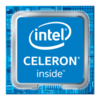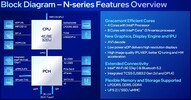Intel Celeron 5205U vs Intel Processor N100
Intel Celeron 5205U
► remove from comparison
The Intel Celeron 5205U is a power efficient entry-level dual-core SoC for notebooks based on the Comet Lake (CML-U) generation and was announced in October 2019. Compared to the similar Whiskey Lake Celeron 4205U processors, the difference is the higher clock speed (+100 MHz) and support for faster memory. The processor cores are clocked at only 1.9 GHz (no Turbo) and don't support SMT / HyperThreading (so only 2 threads). More information on Comet Lake and all the models and articles on it can be found here.
The integrated graphics adapter is still the same as in the previous generations. It is called only Intel UHD Graphics but is still the same Intel UHD Graphics 610 like in the Pentium 4205U. Furthermore, the SoC integrates a VP9 and H.265 de- and encoder and an integrated dual channel LPDDR3-2133/DDR4-2400 memory controller (compared to DDR4-2666 in the faster and costlier Core i3/i5/i7 processors).
Performance
While we have not tested a single system powered by the 5205U as of August 2023, it's safe to expect the chip to be about half as fast as the Core i3-10110U (Comet Lake, 2 cores, 4 threads, up to 4.1 GHz). Which is nothing to write home about, really, as of mid 2022.
Power consumption
This Celeron has a default TDP, also known as the long-term power limit, of 15 W. Intel officialy allows laptop manufacturers to reduce that value somewhat, 12.5 W being the lower limit, resulting in lower clock speeds and lower performance. Unlike most Comet Lake family processors, Celeron 5205U is fairly likely to actually stick to that limitation as its cores are not Boost-enabled.
Last but not the least, this CPU is manufactured on an old, as of late 2022, 14 nm Intel process making for subpar energy efficiency.
Intel Processor N100
► remove from comparison
The Intel Processor N100 is an entry-level mobile CPU for thin and light laptops from the Alder Lake-N series. It was announced in early 2023 and offers no performance cores and 4 of the 8 efficient cores (E-cores, Gracemont architecture). The chip does not support HyperThreading and clocks with 1 to 3.4 GHz. The performance of the E-cores should be similar to old Skylake cores (compare to the Core i7-6700HQ). All cores can use up to 6 MB L3-cache.
Performance
The average N100 in our database delivers unimpressive multi-thread benchmark scores that are most similar to those of the Core i3-1115G4. The chip is fast enough for many day-to-day tasks, but not much more than that; the other thing to keep in mind is that of the two N100-toting systems tested by us as of October 2023, both have rather high CPU power limits. The chip will be noticeably slower if limited to just six or seven Watts.
Features
The Alder Lake-N chips only support single channel memory with up to DDR5-4800, DDR4-3200 or LPDDR5-4800. The chip also supports Quick Sync and AV1 decoding (most likely same engine as in Alder Lake). Furthermore, Wi-Fi 6E and Bluetooth 5.2 are partly integrated (but no Thunderbolt). External chips can be connected via PCIe Gen3 x9 (via the PCH).
The integrated graphics adapter is based on the Xe-architecture and offers only 24 of the 32 EUs (Execution Units) operating at only 450 - 750 MHz. Due to the single channel memory, low clock speeds, and low shader count, the gaming performance of the iGPU is very limited.
Power consumption
The N100 has a base power consumption of only 6 W and is therefore suited for fanless cooling. The CPU is built with a further improved 10nm SuperFin process at Intel (called Intel 7).
| Model | Intel Celeron 5205U | Intel Processor N100 | ||||||||||||||||||||||||||||||||||||||||||||||||||||||||||||||||||||
| Codename | Comet Lake-U | Alder Lake-N | ||||||||||||||||||||||||||||||||||||||||||||||||||||||||||||||||||||
| Series | Intel Comet Lake | Intel Alder Lake-N | ||||||||||||||||||||||||||||||||||||||||||||||||||||||||||||||||||||
| Series: Alder Lake-N Alder Lake-N |
|
| ||||||||||||||||||||||||||||||||||||||||||||||||||||||||||||||||||||
| Clock | 1900 MHz | 1000 - 3400 MHz | ||||||||||||||||||||||||||||||||||||||||||||||||||||||||||||||||||||
| Cores / Threads | 2 / 2 | 4 / 4 4 x 3.4 GHz Intel Crestmont E-Core | ||||||||||||||||||||||||||||||||||||||||||||||||||||||||||||||||||||
| TDP | 15 Watt | 6 Watt | ||||||||||||||||||||||||||||||||||||||||||||||||||||||||||||||||||||
| Technology | 14 nm | 10 nm | ||||||||||||||||||||||||||||||||||||||||||||||||||||||||||||||||||||
| max. Temp. | 100 °C | 105 °C | ||||||||||||||||||||||||||||||||||||||||||||||||||||||||||||||||||||
| Socket | BGA1528 | BGA1264 | ||||||||||||||||||||||||||||||||||||||||||||||||||||||||||||||||||||
| Features | LPDDR3-2133/DDR4-2400 RAM, PCIe 2, 4 GT/s bus, MMX, SSE, SSE2, SSE3, SSSE3, SSE4.1, SSE4.2, AVX, AVX2, BMI2, ABM, FMA, ADX, VMX, SMEP, SMAP, MPX, EIST, TM1, TM2, SST, AES-NI, RDRAND, RDSEED, SGX | DDR4-3200/DDR5-4800/LPDDR5-4800 RAM (sin. chan.), PCIe 3, GNA, MMX, SSE, SSE2, SSE3, SSSE3, SSE4.1, SSE4.2, AVX, AVX2, BMI2, ABM, FMA, ADX, VMX, SMEP, SMAP, EIST, TM1, TM2, Turbo, SST, AES-NI, RDRAND, RDSEED, SHA | ||||||||||||||||||||||||||||||||||||||||||||||||||||||||||||||||||||
| iGPU | Intel UHD Graphics 610 (300 - 900 MHz) | Intel UHD Graphics 24EUs (Alder Lake-N) ( - 750 MHz) | ||||||||||||||||||||||||||||||||||||||||||||||||||||||||||||||||||||
| Architecture | x86 | x86 | ||||||||||||||||||||||||||||||||||||||||||||||||||||||||||||||||||||
| $107 U.S. | $128 U.S. | |||||||||||||||||||||||||||||||||||||||||||||||||||||||||||||||||||||
| Announced | ||||||||||||||||||||||||||||||||||||||||||||||||||||||||||||||||||||||
| Manufacturer | ark.intel.com | ark.intel.com | ||||||||||||||||||||||||||||||||||||||||||||||||||||||||||||||||||||
| L3 Cache | 6 MB |
Benchmarks
Average Benchmarks Intel Celeron 5205U → 100% n=2
Average Benchmarks Intel Processor N100 → 258% n=2
* Smaller numbers mean a higher performance
1 This benchmark is not used for the average calculation













